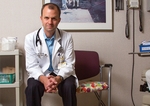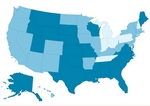business
Retail clinics' role in U.S. health system yet to be defined
■ A new study details possible changes, including pay structures that offer incentives to coordinate care among clinics, physicians and hospitals.
By Pamela Lewis Dolan — Posted Sept. 6, 2010
- WITH THIS STORY:
- » Attributes for retail clinics
- » External links
- » Related content
Before retail health clinics can become a part of the wider health care delivery system, federal policy may be needed to encourage the coordination of care between retail clinics and primary care physicians.
This finding is according to a study published in August by the RAND Corp., on behalf of the Office of the Assistant Secretary of Planning and Evaluation of the Dept. of Health and Human Services.
HHS commissioned the study, "Policy Implications of the Use of Retail Clinics," to determine what role retail clinics play in the U.S. health care system. The study said more research is needed to determine how retail clinics fit within the health care system. But the study details policy implications to consider, including a change in reimbursement structures to offer incentives for care coordination among retail clinics, physicians and hospitals.
The report included an analysis of peer-reviewed studies of the industry and media reports, including those from American Medical News, and interviews with leaders of the retail clinic industry and other health care sectors. RAND conducted a panel discussion of nine health care leaders, including a representative from the American Medical Association.
The study said that although retail clinics have been around for more than 10 years, there has been little in the way of federal policymaking that would affect them. As the federal government begins to examine the role clinics might play post-health system reform, the clinics have struggled to define their role.
Not so underserved
Once touted as an affordable option for the uninsured and an answer to areas struggling with physician shortages, the study found that only 13.6% of U.S. Census tracts served by retail clinics would be considered medically underserved, and that 25% of census tracts outside clinics' service areas are medically underserved. In addition, 12.5% of the population served by retail clinics are in federally designated Health Professional Shortage Areas. Outside the clinics' markets, 20.9% of patients are considered to be in shortage areas.
Meanwhile, uninsured patients account for only 16% to 27% of clinics' patient volume, and 61% of retail clinic patients already have primary care physicians. The study said many clinics don't take Medicaid because reimbursement is too low.
RAND fixed the number of clinics at 1,200 in 33 states, with half in California, Florida, Illinois, Minnesota and Texas.
Minnesota, where the retail clinic concept began, recently became the first state where a public hospital opened a retail clinic, RAND said.
The new health system reform law is expected to add more than 30 million people to the rolls of the insured. Reform also emphasizes the patient-centered medical home concept, which would put primary care physicians in charge of coordinating care delivered at several entry points to be connected electronically. Retail clinics hope to take advantage by becoming one of those points of care. As the study showed, however, there are conflicting views of the relationship between retail clinics and primary care practices.
The study found that some physicians view the clinics as a danger to their practices. However, there are examples of where retail clinics have formed a mutually beneficial relationship with those practices, RAND said. In some cases, retail clinics not directly owned or operated by a hospital or a physician group have benefited from referrals by the clinics when additional care is needed.
Likewise, physicians have benefited from having a place to send non-acute patients, freeing up time for more complex cases or easing an overbooked schedule. However, other experts RAND talked to said the relatively minor cases handled by retail clinics make up the bread-and-butter of their practice, which is why the clinics could represent a threat.
Lori Heim, MD, president of the American Academy of Family Physicians, said she agrees that a mutually beneficial relationship has been forged in some cases between retail clinics and primary care physicians. "There aren't many, only a few examples here and there," she said.
Desirable qualities
The AAFP approved policy in 2007 that detailed attributes for retail clinics to adopt, including a limited scope of service and formal connections to the local physician community.
Dr. Heim said the policy was drafted with the cooperation of some major players in the retail clinic market. The AAFP also had the support of several physician associations, including the American Medical Association, which signed on to the AAFP attributes. AMA policy calls for the continued monitoring of the clinics' effects on the health care marketplace.
Dr. Heim said the AAFP decided in January to revise its policy when it realized that many retail clinic operators were not sticking to the agreed-upon attributes. The revised AAFP policy states that the AAFP does not endorse retail clinics, which have the potential to further fragment care.
MinuteClinic, one group that worked with the AAFP on developing the attributes, says it is still abiding by them.
The company is taking the relationship with physicians one step further by establishing formal affiliations with several health systems, including Cleveland Clinic, said Andrew Sussman, MD, president of MinuteClinic and senior vice president and associate chief medical officer of CVS Caremark, which owns the MinuteClinic chain. Several other clinic chains have set out to form strategic partnerships with health systems.
Gabe Weissman, spokesman for Take Care Health Systems, a retail clinic chain purchased by Walgreen Corp. in 2007, said many of the business relationships clinics have with physician practices were built on individual relationships that already existed in the community, such as those between physicians other health professionals and between primary care doctors and subspecialists.
"Partnerships take many forms at the local community level, but the focus is on patient-centered care and providing accessible, affordable, convenient quality care to patients," said Tine Hansen-Turton, executive director of the Convenient Care Assn., a trade group for clinic operators.
The AAFP policy still outlines attributes for clinics, but in the context of what the clinics should have before physicians decide to work with them.
"What we said to members is: Here are the potential problems, and they are significant," Dr. Heim said. "But if you have a local retail health clinic that can work with you to the benefit of your practice and your patients, then you should enter into those discussions."












